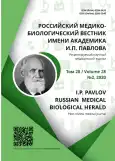A study of influence of progesterone on activity of Glycoprotein-P in vitro
- Authors: Erokhina P.D.1, Abalenikhina Y.V.1, Shchulkin A.V.1, Chernykh I.V.1, Popova N.M.1, Slepnev A.A.1, Yakusheva E.N.1
-
Affiliations:
- Ryazan State Medical University
- Issue: Vol 28, No 2 (2020)
- Pages: 135-142
- Section: Original study
- URL: https://journals.rcsi.science/pavlovj/article/view/34901
- DOI: https://doi.org/10.23888/PAVLOVJ2020282135-142
- ID: 34901
Cite item
Abstract
Background. Glycoprotein-P (Pgp, АВСВ1) is a transporter protein participating in pharmacokinetics of medical drugs, and also in development of resistance of tumor cells to chemotherapy.
Aim. To study the influence of progesterone on the activity of Pgp in vitro on a cell model of human small intestinal epithelium.
Materials and Methods. The work was conducted on Caco-2 cells. The activity of Pgp was evaluated by transport of fexofenadine in a special transwell-system. Concentration of fexofenadine was analyzed by HPLC method. The amount of Pgp was determined by EIA method. Four series of experiments were conducted: control – cells preincubated with clean transport medium without addition of any substances; influence of rifampicin on the activity and synthesis of Pgp in the concentration 10 µmol/l in preincubation for 3 days (induction control); influence of progesterone on the activity of Pgp in concentrations 1, 10 and 100 µmol/l in preincubation for 30 min; influence of progesterone on the activity and synthesis of Pgp in concentrations 1, 10 and 100 µmol/l in preincubation for 3 days.
Results. Progesterone in the concentrations 1 and 10 µM in incubation with cells within 30 minutes did not show any reliable influence on the activity of Pgp, however, in concentration 100 µM it reduced the activity of the transporter protein.
In incubation of Caco-2 cells with progesterone in concentrations 1, 10 and 100 µM within 3 days the activity of Pgp remained unchanged. Progesterone in concentration 100 µM in incubation within 3 days significantly increased synthesis of Pgp in enterocytes by 114.3% as compared to control, and in other used concentrations (1 and 10 µM) it produced no reliable effect.
Conclusion. In in vitro experiments on Caco-2 cells progesterone in concentration 100 µM produces a direct inhibiting effect on the activity of Pgp; however, in incubation within 3 days it increases synthesis of the transporter protein, which cancels out its inhibitory activity.
Keywords
Full Text
##article.viewOnOriginalSite##About the authors
Pelageya D. Erokhina
Ryazan State Medical University
Email: p34-66@yandex.ru
ORCID iD: 0000-0003-4802-5656
Student
Russian Federation, RyazanYulia V. Abalenikhina
Ryazan State Medical University
Email: p34-66@yandex.ru
ORCID iD: 0000-0003-0427-0967
SPIN-code: 4496-9027
ResearcherId: L-8965-2018
PhD in Biological Sciences, Assistant Professor of the Department of Biological Chemistry
Russian Federation, RyazanAlexey V. Shchulkin
Ryazan State Medical University
Email: p34-66@yandex.ru
ORCID iD: 0000-0003-1688-0017
SPIN-code: 2754-1702
ResearcherId: N-9143-2016
MD, PhD, Assistant Professor of the Department of Pharmacology with a Course of Pharmacy of Continuing Professional Education Faculty
Russian Federation, RyazanIvan V. Chernykh
Ryazan State Medical University
Email: p34-66@yandex.ru
ORCID iD: 0000-0002-5618-7607
SPIN-code: 5238-6165
ResearcherId: R-1389-2017
PhD in Biological Sciences, Head of the Department of Pharmaceutical Chemistry
Russian Federation, RyazanNatalia M. Popova
Ryazan State Medical University
Author for correspondence.
Email: p34-66@yandex.ru
ORCID iD: 0000-0002-5166-8372
SPIN-code: 7553-9852
ResearcherId: B-1130-2016
MD, PhD, Assistant Professor of the Department of Pharmacology with a Course of Pharmacy of Continuing Professional Education Faculty
Russian Federation, RyazanAlexandr A. Slepnev
Ryazan State Medical University
Email: p34-66@yandex.ru
ORCID iD: 0000-0003-0696-6554
PhD in Biological Sciences, Assistant Professor of the Department of Pharmacology with a Course of Pharmacy of Continuing Professional Education Faculty
Russian Federation, RyazanElena N. Yakusheva
Ryazan State Medical University
Email: p34-66@yandex.ru
ORCID iD: 0000-0001-6887-4888
SPIN-code: 2865-3080
ResearcherId: T-6343-2017
MD, PhD, Professor, Head of the Department of Pharmacology with a Course of Pharmacy of Continuing Professional Education Faculty
Russian Federation, RyazanReferences
- Yakusheva EN, Shulkin AV, Popova NM, et al. Structure, functions, of P-glycoprotein and its role in rational pharmacotherapy. Reviews on Clinical Pharmacology and Drug Therapy. 2014;(2):3-11. (In Russ).
- Yakusheva EN, Chernykh IV, Shulkin AV, et al. Methods of identification of drugs as P-glycoprotein substrates. I.P. Pavlov Russian Medical Biological Herald. 2015;(3):49-53. (In Russ).
- Gatsanoga MV, Chernykh IV, Shchulkin AV, et al. The method of assessment of drugs belonging to the substrates of P-glycoprotein on female rabbits. Nauka Molodykh (Eruditio Juvenium). 2016;(3):5-10. (In Russ).
- Shchulkin AV, Chernykh IV, Yakusheva EN, et al. Influence of progesterone on P-glycoprotein functional activity in experiment. Khimiko-Farmatsevticheskii Zhurnal. 2018;52(7):3-8. (In Russ). doi: 10.30906/0023-1134-2018-52-7-3-8
- Coles LD, Lee IJ, Voulalas PJ, et al. Estradiol and progesterone-mediated regulation of P-gp in P-gp overexpressing cells (NCI-ADR-RES) and placental cells (JAR). Molecular Pharmaceutics. 2009;6(6): 1816-25. doi: 10.1021/mp900077q
- Fröhlich M, Albermann N, Sauer A, et al. In vitro and ex vivo evidence for modulation of P-glycoprotein activity by progestins. Biochemical Pharmacology. 2004;68(12):2409-16. doi: 10.1016/j.bcp.2004.08.026
- Petri N, Tannergren C, Rungstad D, et al. Transport characteristics of fexofenadine in the Caco-2 cell model. Pharmaceutical Research. 2004;21(8):1398-404. doi: 10.1023/b:pham.0000036913.90332.b1
- Elsby R, Surry DD., Smith VN, et al. Validation and application of Caco-2 assays for the in vitro evaluation of development candidate drugs as substrates or inhibitors of P-glycoprotein to support regulatory submissions. Xenobiotica. 2008;38(7-8):1140-64. doi: 10.1080/00498250802050880
- Kliewer SA, Moore JT, Wade L. An orphan nuclear receptor activated by pregnanes defines a novel steroid signaling pathway. Cell. 1998;92(1):73-82. doi: 10.1016/s0092-8674(00)80900-9
- Watanabe K, Jinriki T, Sato J Effects of progesterone and norethisterone on cephalexin transport and peptide transporter PEPT1 expression in human intestinal cell line Caco-2. Biological & Pharmaceutical Bulletin. 2006;29(1):90-5. doi: 10.1248/bpb.29.90
Supplementary files








